#subject to change in the future as I figure out my workflow
Explore tagged Tumblr posts
Text
COMMISSION INFO
I will be opening 1 - 2 single character commission slots later this week in a later announcement.
A third slot is already on hold. I may open up more complex scenarios and additional characters later on, but I want to start simple.
My prices and terms are below, if you're interested please have your references ready when you reach out.
——SINGLE CHARACTER COMMISSIONS——
All prices include up to 1 full body character.
Clean sketch $35
Inked drawing, add $15. ($50 total)
Flat colors, add $10. ($60 total)
Rendered, add $25 ($85 total)
Clean sketch style examples:

Inked drawing style examples:

Flat color style examples:

Rendered style examples:

Currently unavailable:
Backgrounds
Complex comic pages
NSFW
I Refuse to Draw:
Hateful, discriminating content
Payment:
Invoice will be sent from me to you through PayPal– USD$.
Upfront payment is required for $50 and below commissions (Sketch/Ink).
50% upfront/50% upon completion is an option for any commissions above $50 if you prefer it.
Process:
I take commissions when I feel I can complete them within a week, and would like to get started within 24 hours of receiving payment.
If you want me to use a character reference, have all reference documents ready at the time payment is sent. I will not be able to wait for you to gather materials after requesting a commission.
A rough sketch will be sent to you for review within 1-2 days. At this point, you can ask for major tweaks to the art– (poses, outfits, expressions, etc.)
If you want a specific inking/rendering method (crisp clean lines vs. the textured pen I usually use, or soft shading vs. cel-shading), please let me know by the time the rough sketch is approved.
Example of what to expect from the rough sketch:

Only after the rough sketch is approved, will I start cleaning up the sketch, inking, and coloring.
The finished product will be sent as a PNG via email. PSD available upon request. If using a 50/50 payment method, the final image will be sent after final payment.
Terms:
Commissions are for personal use only, unless we agree on different arrangements.
Do not remove my signature, unless we agree on different arrangements.
Do not modify the finished artwork to promote hateful ideology.
Do not claim my artwork as your own.
NO REFUNDS after the rough sketch is approved and work has begun.
35 notes
·
View notes
Photo
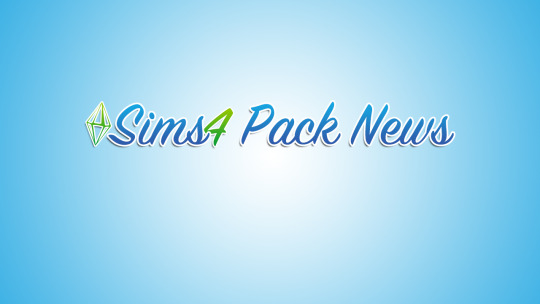
Welcome back to our latest - and last! - Deep Dive into the gameplay of The Sims 4 Nifty Knitting Stuff Pack. I’ve really enjoyed sharing the designs and development of this pack with you, and I hope to continue doing these sorts of posts in the future. It’s been a super cool experience, and I hope you’ve enjoyed reading these! In today’s post I’ll talk about the feature that is core to everything in this pack, Knitting! Once again, I have to remind you that we’re still in active development on the pack and so some things may change between now and the final game. Now, let’s talk about some nifty knits!
READ IT I PROMISE YOU GONNA LIKE IT!
In order to start knitting, you’ll need to purchase a Yarn Basket from the Build/Buy catalog. You probably remember voting on these baskets a while back. This was the winning design, presented to you now in all its colorful glory! Don’t like color? That’s okay, because we included a solid black and white variant.
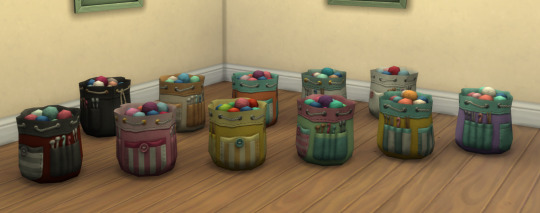
We have one more knitting basket coming too! Remember this one?
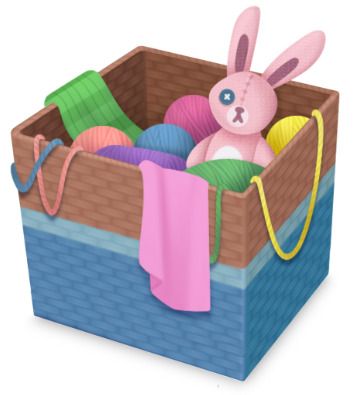
The basket acts as the crafting catalyst(neat term, huh?) similar to the Easel or Woodworking Bench in The Sims 4 base game. But unlike those examples, the Yarn Basket is meant to live in a Sim’s inventory so that they can take their knitting anywhere they want to go. Knitting itself is relatively straightforward: click on the Yarn Basket in your inventory, OR, with the basket in your inventory, click on the chair you want to sit in while knitting (perhaps a rocking chair?) and select the Knit interaction. Your projects are saved to your Sim, so you can pause your progress at any time and resume later, and even juggle multiple projects at once. Starting a project costs a small amount of Simoleons for the cost of yarn, but nothing too outrageous.
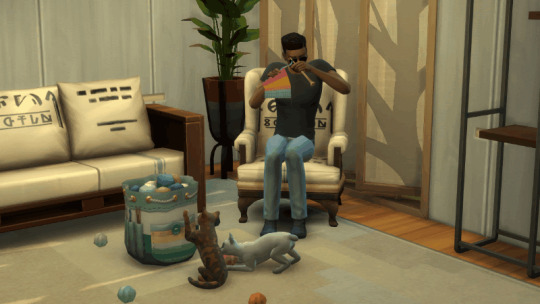
(Children can knit too!) As a Sim levels up their knitting skill they’ll have access to new patterns. They’ll start with knitting socks and beanies, but as they grow more skilled they can tackle more challenging projects like sweaters and toys for kids. But if you only want to specialize in one thing - perhaps knitted mailbox cozies? - that's fine too! Just keep knitting anything and everything, and you’ll be level 10 before you know it. Speaking of knitting skill, sometimes your skill is reflected in your knitted work, or rather your lack of skill. Knitting projects can fail, and when they fail they can get weird. But it’s all subjective, and maybe you’ll end up accidentally knitting the cutest derpy companion, or the perfectly itchy sweater. No mistakes, only happy accidents!

(Just own it.) One of the niftiest parts of the knitting skill is unlocking the ability to Teach to Knit, where Sims sit down together and have a knitting pow-wow. We wanted this to feel special, so we got a really sweet animation for it (Thanks Haeju!). Now that you can infect other Sims with the knitting bug, no yarn ball will be safe!
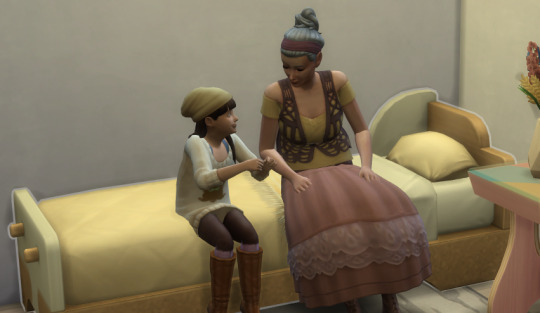
(The knitting needles aren’t finished on the Teach To Knit interaction yet, but trust me it's SUPER CUTE.) So, what can you do with all these knitting projects? Lots of stuff! Not only can knitted objects be listed on Plopsy, but you can also Donate them to charity. If you want to surprise a loved one, try Gifting a knitted object too. If you want to destroy all traces of your knitted failures, you can Frog the object and start again! If it's a particularly nice Sweater that you made, consider Adding it to Wardrobe to make it available in Create-A-Sim to all family members.
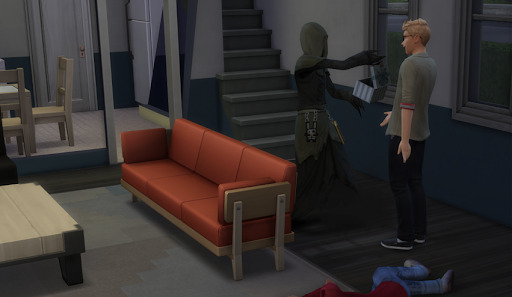
(Everyone appreciates a nice gift!) We want Sims to be able to knit something for their whole family. Not only will Sims be able to knit Toddler Onesies, but Baby Onesies as well. So put your little grubworm in a handmade knitted outfit. I’m sure they’d thank us if they could! (And if they didn’t like it I’m sure they’d be polite about it.)
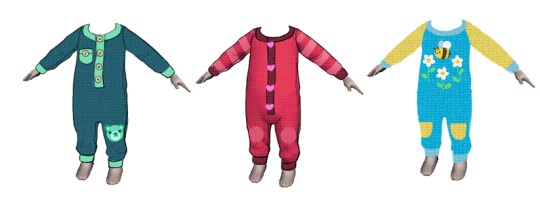
(Here’s a sneak peek at some of the concept art for new clothing for the littlest of Sims!) It also felt like a good idea to add an Aspiration to tie this passion for knitting all together. So if you want to master the fuzzy art of knitting, consider signing your Sim up for the Lord(or Lady) of the Knits Aspiration. With yarn running through your veins, there will be no knitting mountain too hard to conquer! Master the Aspiration and you’ll be rewarded with the Sacred Knitting Knowledge trait. What does it do? Lots of stuff! What does it unlock? Something special! Am I being vague? I am! Come on guys, I can’t share all the secrets quite yet.

As I’ve mentioned previously, we’re trying to get as much cross-pack functionality for knitting as we can. Cats can play with Yarn Baskets and Yarn Balls, there will be new Club rules for Knitting, new class electives at University, and knitting counts for Emotional Control, just to name a few. I’m hoping Knitting feels nice and snug alongside our other gameplay systems. Now let's have a chat with our lead Object Modeler, Beth Mohler! Conor: Can you tell us a little bit about what an Object Modeler does on The Sims 4? Beth: As an object modeler I spend a lot of time trying to figure out how to make objects work in The Sims 4. This is actually a very involved process, and somewhat different from the wonderful work our environment team does. We work with designers, concept artists, engineers, animators, vfx artists (basically everyone!) to make sure that Sims can use an object properly in an animation, or that all of our objects will work with each other. Once we understand the design for a new object, we will create a rig, a block model (a very generic version of the object used to help us make more of the same object in the future), and a footprint (tells us where the object can go and how Sims move around it). Once those are tested by animators and other disciplines we can model the final version, create UVs, and add textures. We also hook up and test everything in the game to make sure it all looks good. There is a lot to think about when it comes to making objects because we know players can find so many interesting ways to place and use them in game. That makes it a very fun challenge to make them work with everything else we’ve built before. Conor: What feature are you most excited to work on in Nifty Knitting Stuff? Beth: I’d say I am most excited to work on the rocking chairs! I love that we are bringing them to the game and can’t wait to see them in some cozy living rooms or on porches. Conor: What are some of the challenges you are facing working on this pack? Beth: One of the biggest challenges is ensuring that the knitting itself looks good and is fun to watch! This is a challenge given that it needs to work for everything you can create. Figuring this out takes a lot of iteration between modeling, animation, engineering, design, and art direction so that we come to a conclusion that will work the best given our time and technical constraints. Another interesting “challenge” is the fact that I crochet as a hobby myself! When you are knowledgeable about something (yarn!) in real life, working on it in the game it can sometimes be hard to separate the things you know and may expect in reality from what is possible or best within a video game. I have to make sure to keep a balance and to conceptualize how we can best convert the knitting experience into The Sims 4. As someone who also generally enjoys interior design and architecture, this is actually one of my favorite challenges and one of the things I love about working on objects in The Sims 4. Conor: What is your favorite feature you have ever worked on in The Sims 4? Beth: I think it has to be a tie between the mini fridge or the robotics table in Discover University. That pack was the first time I got to really take an entire feature from start to finish. I’ve been with Maxis for a while, but I’m relatively new to The Sims 4. Both of these objects had some complex features we wanted that required a lot of iteration. I learned a ton about the technical aspects of our game during the process as well. I’ve also worked on a few very cool things between then and now, but those can’t be shared yet ; ) As a fan of The Sims since the very beginning I am so happy to be able to share a little about what I do on a daily basis on The Sims 4 with you! I haven’t been on The Sims 4 for quite as long overall, but some of you may also recognize me from my time on Sims Mobile where I shared some of our workflows on Twitter for making a juice bar. Thanks! Conor: You shared a screenshot of the In-Progress Rocking Chair in our Rocking Chair Deep Dive. Can you share an updated screenshot now that the Rocking Chair is further along? Beth: I would love to! I hope everyone has been enjoying seeing the progress on this object so far! Here it is a little further along. This program allows us to set the rules for the object materials, footprint size and rig it should use, as well as all the color variants and swatch colors you see in the catalog.
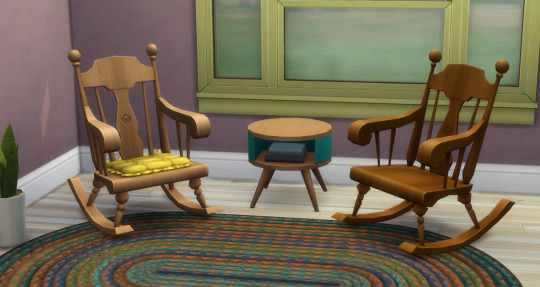
Thanks Beth! By the way, Beth is on Twitter @SimGuruBeth, so be sure to Follow her! And thanks to all of you Simmers for following this pack’s development, this has been a really fun project in a very crazy time. A big thank you to my Stuff Pack teammates, and especially SimGuruSarah who edited my inane ramblings and wrangled the miscellaneous bits for these posts. While this concludes my design Deep Dives, we still have more forum posts with development insights on the way! Keep checking the Community Stuff Pack forum and we’ll have more fun stuff to show off in the weeks to come. Until next time, SimGuruConor
Source: The Sims Forum
272 notes
·
View notes
Text
The Sims 4 Nifty Knitting: Knitting Deep Dive
SimGuruConnor has released a forum post providing details on The Sims 4 Nifty Knitting!
Welcome back to our latest – and last! – Deep Dive into the gameplay of The Sims 4 Nifty Knitting Stuff Pack. I’ve really enjoyed sharing the designs and development of this pack with you, and I hope to continue doing these sorts of posts in the future. It’s been a super cool experience, and I hope you’ve enjoyed reading these!
In today’s post I’ll talk about the feature that is core to everything in this pack, Knitting! Once again, I have to remind you that we’re still in active development on the pack and so some things may change between now and the final game.
Now, let’s talk about some nifty knits!
In order to start knitting, you’ll need to purchase a Yarn Basket from the Build/Buy catalog. You probably remember voting on these baskets a while back. This was the winning design, presented to you now in all its colorful glory! Don’t like color? That’s okay, because we included a solid black and white variant.

We have one more knitting basket coming too! Remember this one?
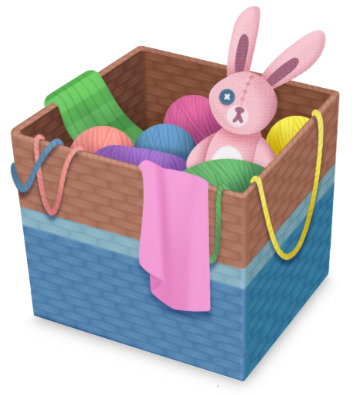
The basket acts as the crafting catalyst(neat term, huh?) similar to the Easel or Woodworking Bench in The Sims 4 base game. But unlike those examples, the Yarn Basket is meant to live in a Sim’s inventory so that they can take their knitting anywhere they want to go. Knitting itself is relatively straightforward: click on the Yarn Basket in your inventory, OR, with the basket in your inventory, click on the chair you want to sit in while knitting (perhaps a rocking chair?) and select the Knit interaction.
Your projects are saved to your Sim, so you can pause your progress at any time and resume later, and even juggle multiple projects at once. Starting a project costs a small amount of Simoleons for the cost of yarn, but nothing too outrageous.
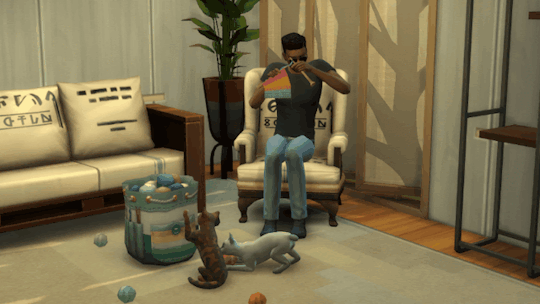
(Children can knit too!)
As a Sim levels up their knitting skill they’ll have access to new patterns. They’ll start with knitting socks and beanies, but as they grow more skilled they can tackle more challenging projects like sweaters and toys for kids. But if you only want to specialize in one thing – perhaps knitted mailbox cozies? – that’s fine too! Just keep knitting anything and everything, and you’ll be level 10 before you know it.
Speaking of knitting skill, sometimes your skill is reflected in your knitted work, or rather your lack of skill. Knitting projects can fail, and when they fail they can get weird. But it’s all subjective, and maybe you’ll end up accidentally knitting the cutest derpy companion, or the perfectly itchy sweater. No mistakes, only happy accidents!

(Just own it.)
One of the niftiest parts of the knitting skill is unlocking the ability to Teach to Knit, where Sims sit down together and have a knitting pow-wow. We wanted this to feel special, so we got a really sweet animation for it (Thanks Haeju!). Now that you can infect other Sims with the knitting bug, no yarn ball will be safe!
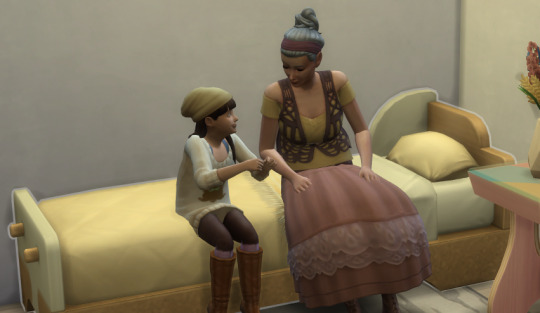
(The knitting needles aren’t finished on the Teach To Knit interaction yet, but trust me it’s SUPER CUTE.)
So, what can you do with all these knitting projects? Lots of stuff!
Not only can knitted objects be listed on Plopsy, but you can also Donate them to charity. If you want to surprise a loved one, try Gifting a knitted object too. If you want to destroy all traces of your knitted failures, you can Frog the object and start again! If it’s a particularly nice Sweater that you made, consider Adding it to Wardrobe to make it available in Create-A-Sim to all family members.

(Everyone appreciates a nice gift!)
We want Sims to be able to knit something for their whole family. Not only will Sims be able to knit Toddler Onesies, but Baby Onesies as well. So put your little grubworm in a handmade knitted outfit. I’m sure they’d thank us if they could! (And if they didn’t like it I’m sure they’d be polite about it.)
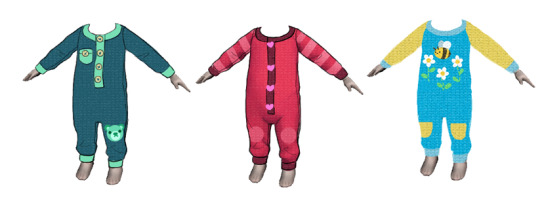
(Here’s a sneak peek at some of the concept art for new clothing for the littlest of Sims!)
It also felt like a good idea to add an Aspiration to tie this passion for knitting all together. So if you want to master the fuzzy art of knitting, consider signing your Sim up for the Lord(or Lady) of the Knits Aspiration. With yarn running through your veins, there will be no knitting mountain too hard to conquer! Master the Aspiration and you’ll be rewarded with the Sacred Knitting Knowledge trait. What does it do? Lots of stuff! What does it unlock? Something special! Am I being vague? I am! Come on guys, I can’t share all the secrets quite yet.
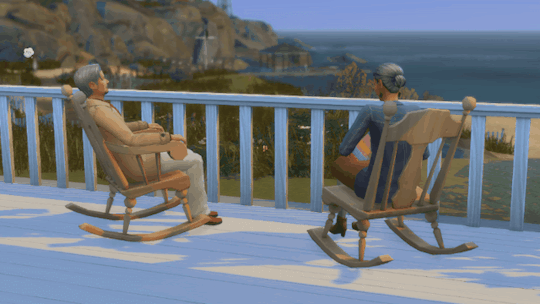
As I’ve mentioned previously, we’re trying to get as much cross-pack functionality for knitting as we can. Cats can play with Yarn Baskets and Yarn Balls, there will be new Club rules for Knitting, new class electives at University, and knitting counts for Emotional Control, just to name a few. I’m hoping Knitting feels nice and snug alongside our other gameplay systems.
Now let’s have a chat with our lead Object Modeler, Beth Mohler!
Conor: Can you tell us a little bit about what an Object Modeler does on The Sims 4?
Beth: As an object modeler I spend a lot of time trying to figure out how to make objects work in The Sims 4. This is actually a very involved process, and somewhat different from the wonderful work our environment team does. We work with designers, concept artists, engineers, animators, vfx artists (basically everyone!) to make sure that Sims can use an object properly in an animation, or that all of our objects will work with each other. Once we understand the design for a new object, we will create a rig, a block model (a very generic version of the object used to help us make more of the same object in the future), and a footprint (tells us where the object can go and how Sims move around it). Once those are tested by animators and other disciplines we can model the final version, create UVs, and add textures. We also hook up and test everything in the game to make sure it all looks good. There is a lot to think about when it comes to making objects because we know players can find so many interesting ways to place and use them in game. That makes it a very fun challenge to make them work with everything else we’ve built before.
Conor: What feature are you most excited to work on in Nifty Knitting Stuff?
Beth: I’d say I am most excited to work on the rocking chairs! I love that we are bringing them to the game and can’t wait to see them in some cozy living rooms or on porches.
Conor: What are some of the challenges you are facing working on this pack?
Beth: One of the biggest challenges is ensuring that the knitting itself looks good and is fun to watch! This is a challenge given that it needs to work for everything you can create. Figuring this out takes a lot of iteration between modeling, animation, engineering, design, and art direction so that we come to a conclusion that will work the best given our time and technical constraints.
Another interesting “challenge” is the fact that I crochet as a hobby myself! When you are knowledgeable about something (yarn!) in real life, working on it in the game it can sometimes be hard to separate the things you know and may expect in reality from what is possible or best within a video game. I have to make sure to keep a balance and to conceptualize how we can best convert the knitting experience into The Sims 4. As someone who also generally enjoys interior design and architecture, this is actually one of my favorite challenges and one of the things I love about working on objects in The Sims 4.
Conor: What is your favorite feature you have ever worked on in The Sims 4?
Beth: I think it has to be a tie between the mini fridge or the robotics table in Discover University. That pack was the first time I got to really take an entire feature from start to finish. I’ve been with Maxis for a while, but I’m relatively new to The Sims 4. Both of these objects had some complex features we wanted that required a lot of iteration. I learned a ton about the technical aspects of our game during the process as well. I’ve also worked on a few very cool things between then and now, but those can’t be shared yet ; )
As a fan of The Sims since the very beginning I am so happy to be able to share a little about what I do on a daily basis on The Sims 4 with you! I haven’t been on The Sims 4 for quite as long overall, but some of you may also recognize me from my time on Sims Mobile where I shared some of our workflows on Twitter for making a juice bar. Thanks!
Conor: You shared a screenshot of the In-Progress Rocking Chair in our Rocking Chair Deep Dive. Can you share an updated screenshot now that the Rocking Chair is further along?
Beth: I would love to! I hope everyone has been enjoying seeing the progress on this object so far! Here it is a little further along. This program allows us to set the rules for the object materials, footprint size and rig it should use, as well as all the color variants and swatch colors you see in the catalog.

Thanks Beth! By the way, Beth is on Twitter @SimGuruBeth, so be sure to Follow her! And thanks to all of you Simmers for following this pack’s development, this has been a really fun project in a very crazy time. A big thank you to my Stuff Pack teammates, and especially SimGuruSarah who edited my inane ramblings and wrangled the miscellaneous bits for these posts.
While this concludes my design Deep Dives, we still have more forum posts with development insights on the way! Keep checking the Community Stuff Pack forum and we’ll have more fun stuff to show off in the weeks to come.
Until next time, SimGuruConor
37 notes
·
View notes
Text
How did we get here?
Since my last post “Don't you know that you're toxic?”, I thought more and more about how I (and when I say I, I mean we as people) process things happening in and around our lives.
How did we get here?
In my 20's, I worked in the UK in offices with a lot of other folks. My work was very computer based, and I enjoyed figuring out the quickest and easiest way to get things done. I learned the old school ways, but I was eager to find a new process that helped speed up my work. I learned a lot of short cuts and eventually had a quick workflow. People were impressed.
Some colleagues would process everything manually just as their bosses had shown them, but I spent the time figuring how to get a quicker answer from a larger sample of data by refining my skills.
I realized it was the process that I was really interested in.
How could I do this more efficiently? How could I make sure I am getting the most out of this workflow? Is this even my responsibility? Can I change how I am doing this, to get better faster and get more accurate results?
Is this the best way to do this?
This is how I still live my life, except rarely is it in front of a database anymore, now it's more about how I reflect and develop myself. I still feel it is not the result that I care so much about, it's about how you get to that result.
Let's take the blog post I published about my ex partner.
I published that blog to process my thoughts and feelings. I felt things, realized I'd bottled it up too long and it was time to let it out. I felt that as I had written a few blogs recently which helped me process my feelings and thoughts on both happy and sad subjects and I was happy with the development within myself after posting, I would do it again. I wanted to express how I processed our relationship, break up and post break up mess. Easy.
So, what was really interesting to me was how other people processed my blog so differently.
Extremes at both ends!
There were also the ones who didn't respond; didn't say anything, why is that? Because they didn't care or have any thoughts about what I wrote? Because they didn't want to have a conversation with me that they thought might become awkward? Because they already saw negative comments and didn't want to give an opinion for or against?
I received private messages from folks who understood the purpose of the blog and how I still cared for my ex and mean her no harm. I had other people who (may or may not have read the blog completely) felt I was cruel and mean to publish such a thing and decided to publicly shame me.
Ironically, these messages and comments (good or bad) are just people's reaction after processing their thoughts and feelings as I had done while writing it.
In fact, while I write (even now) I refine how I write... It's a process within a process... Am I writing this document the best way I can? Is it complete? Should I clarify points further or delete parts that are useless information? Am I writing how I really feel or am I glossing over parts?
Funnily enough, I am surprised that none of the comments on the negative side affected me. I felt totally fine about someone called me a name or told me I was not a good person for posting something.
I realize I have learnt to process those negative responses in a way that doesn't actually affect me personally. That was an outcome which I did not expect, but I was really pleased about.
In therapy we did talk about how people have treated me at times. My doc helped me realize while it's not OK, I should remember anyone's opinion of me, is just that: it's their opinion.
I really enjoyed the fact that I didn't feel any issue about them taking issue to my writing. Having a different point of view is totally fine. In fact I encourage folks to contact me to give me feedback, although I do prefer constructive criticism over personal attacks. But either way, I'm fine with it.
I stopped drinking alcohol almost 6 years ago... What a process that was, but I got there.
I hit my rock bottom in early 2015 (not surprisingly during a drunk fight with the above mentioned ex) and to get out of a psychiatric hospital in a foreign country, I promised the doctor I would not drink again. Just so you know, I have never felt better after making that decision, but the processing of my feelings, anxiety and depression were far from over.
Even to this day I am learning new ways to cope, to evaluate and to process in my heart, mind and soul what is happening around me and, more importantly, within me.
Ask any of my old band members, they'll remember in mid 2017 when I was a couple of years sober, I was struggling on tour socially. At the time I couldn't handle tour life. You see, I used to drink to medicate myself to be the life of the party. Now, as I had to face the issue of social anxiety head on or stay in bed, I realized I had to open up to my band members and ask them for support and understanding while I process what was happening within me.
I was learning to process my insecurities. I learned that speaking up isn't such a bad thing. Being vulnerable isn't such a bad thing...
After all, I'm only human...
It took me many months to come to terms with another band whose band members weren't actually friends. I thought all bands members in all bands were friends. After all they share the cool vibes on stage... It's how I have experienced it all my life. But this was a working band. Eventually the only way I could go on was by thinking, “this is a job, and you don't always have to get along with your colleagues as friends.” I figured out a process that worked for me! I had to act on stage, and off stage, well, I did my own thing. It was tough at first, but I got there... After all, it is a process.
By the way, those band members weren't particularly mean, they just had their way and I had to learn it. No harm, no foul.
For 7 years, with the help of my therapist in Germany, I learned more and more ways to cope, to process and to learn. I'm forever grateful for that process we went through together. The workflow... The goals... The listening... The talking... It was an amazing experience...
Now that I don't have a doc, I'm finding new ways to cope with my issues (a new process to replace the old process...). That would be this blog... Just writing about my problems helps me process them and learn that really, I am doing well, I am handling things pretty well and my future isn't as gloomy as I once thought.
I have surrounded myself with some amazing friends and I have a great family too. Just like talking to my band members, opening up and talking about my problems and fears has really given my life a positive turn.
I always thought I should behave like a man... And a man shouldn't cry, shouldn't tell someone he loves them (other than his Mum and wife) and has a duty to be stoic and tough... I am not that kind of man... I am human... I make mistakes, I have feelings and I know now, to talk about it all, to share it, helps me process it.
Often, just pressing “publish” after writing gives me a wave of relief.
For months and months I've been holding in my feelings about my daughter, Mijita, who I blogged about a few weeks ago. I had many sleepless nights, crying in frustration that I let her go. I couldn't even look at a photo of her, without crying and feeling guilty. I felt pain. I was silly, and kept a lot of that in. I had to change how I was processing the loss of her in my life.
Then I wrote about her.
I hadn't told anyone (other than a few close friends) how important she is to me until that public display of love and devotion. And it was a like a 1000 kilos were taken off my shoulders...
Today I looked at a few photos of her, and I smiled. She is such a wonderful dog, and I miss her so, but now I'm starting to think back with happiness. We spent 4.5 years together, trained, swam, hiked and explored the world together. We grew together, she was my first. I am learning to be grateful for her in my life, not sad that she's no longer with me.
I've started to process the grief I felt.
Writing about Mijita has helped me so much with the trauma of saying goodbye to her... What a process... I'm so glad I figured out a way to find love again...
I will not look at my phone ever again just before going to sleep. Why? Because if I do get any message, from anyone, it sets the mood for my sleep. If I had just learned not to read those messages earlier, I'd have slept better on many many occasions.
The process is, don't look at your phone if you wanna sleep well tonight. I love learning...
Yes, I know it's a pretty simple thing to know—most of us know it—but my wife could easily read a message before bed and just roll over and sleep... Me, my brain thinks and thinks and doesn't let up. I'm going around in circles in my head, then I start thinking about other things, the past, the future... scenario after scenario... And I'm wide awake for another 2 hours... Sometimes crying... Sometimes wishing I could shut off... Damn you boy, just don't pick up the phone!
Speaking of my wife, she has ASD. Yes, that means she has what most of us know as Aspergers.
I'm always learning new processes to help our relationship. She is a unique person, and unlike most folks I know. I have learned to be as direct as possible. To be as open as possible. To make sure I am clear with any “suggestions”. I've learned to listen to her too, and to clarify anything that could be a “suggestion” or a direct request. I know she processes things differently to me, so I have to take steps towards her if I want to communicate with her.
We have a workflow, a process, a relationship. It's unique to us, and it works for us. It keeps us talking openly. It keeps us in love.
I know I have to keep an eye out for her in social situations so that she doesn't feel too overwhelmed and she knows full well how my anxiety can kick in (sometimes at the same time!). We help support each other's process... And gosh damn it, I love the fact that we process our processes together..
Sometimes I forget about my past. What I mean is, I forget that I lived in Germany or the UK, I have like a black spot in my memory. I may even forget some of my friends! I forget some of the wonderful experiences I have had in my 18 years there. The next minute, I'm sad and missing the hell out of Europe!! What's up with that?? I still haven't figured that one out... Any ideas?
Of course then I feel guilty that I even forgot such amazing people, places and experiences in my life!
I've had long discussions with Alex about ourselves and others, figuring out ways to process what is happening within us and around us. We suggest theories back and forwards at a rate of knots. I've also had long extensive discussions with close friends about “people”, and how and why they do the things they do... Or how and why I do things... ! I love it... The theoretical hypothesis... and sometimes conclusions... And sometimes more processing... Sometimes no solution...
Recently I've been working on my part of Alex's visa application to live in Australia. It's a real pain in the butt, but part of the process for me, was figuring out the workflow and best practices to systematically provide evidence of our genuine and continuous relationship. Here I am at a computer, once again, figuring out the best way to make sure nothing is left behind, the results are full and complete and that I am satisfied with the quality of my work.
I continuously question what I am doing... Is it the best way? Can I do better?
Refine the process... Strive for success... Develop Ideas... Evaluate solutions...
Don't we all do that??
If I'm not happy with how I feel, or how I'm feeling about something, I look at the way I've been dealing with it. I look at ways to change the process to gain a more comfortable feeling/result. Maybe I look at it from a different point of view. Maybe I question my reasons for feeling bad in the first place. Maybe I ask someone to be a sounding board for ideas how to cope better.
Often times, the solution, or change of process that I come up with, is not an easy one to execute, sometimes it confronts my belief system, sometimes it's really hard (like a break up) but the result is actually an easy life... Didn't someone once quote “hard choices, easy life... easy choices, hard life” ???
I hope my ex will reach out one day, to show me she has learned how to process breakups in a new and much improved way. I mean, that would be awesome, wouldn't it? I'd love to learn how she got to that point, what thought process she took. What feelings she had to get to the point she could contact me again.
I'd answer her call without malice, without agenda, without judgement. Only interest... Cause my first question would be:
“How did we get here?”.
That's right, no hard feelings. Not to my ex, not to those who wrote negative comments, not to anyone...
Honestly I've just tried to use this blog as a way to process my thoughts and feelings, to help you and me, by sharing what's on my mind and in my heart.
Thanks for reading and being part of the process,
Josh
3 notes
·
View notes
Text
FIST JAM OPS III POSTMORTEM
I am happy to report that my submission got first place in the STYLE category of the jam! There were lots of really amazing submissions, so please be sure to give the other works a look. Some of the stuff in there is crazy!!
In this post I hope to detail how I designed my submission, what stuff got cut (no pun intended), and what stuff will hopefully see the light of day in the future.
My original plan for the jam was to make a kit of printable props:
A Zippo lighter
A matchbook
A box of cigarettes
A pistol
It became clear rather quickly that I really didn't have the time to make all of these in a month, especially with the other game development duties that I needed to manage at the time. It's easy to prototype out these props, but it is much harder to:
Design a printout that can be used to reliably reproduce a robust final prop
Design clear written and diagrammatic instructions of the assembly steps for each prop
Optimize page layouts to reduce waste
Scan, clean up, and prepare promotional materials for each prop
Fill the pages with interesting and unique flavor
I definitely didn't do myself any favors when I decided I wanted to do the whole thing traditionally end-to-end using ink on paper (I used a Hi-Tec-C). What you see on the final sheet was me just going straight through the whole final draft in ink with no pencil sketches. I did draft up the "greeting" text on a computer before I wrote it, but otherwise I did everything as I went all in one go.
In general, I have grown kind of disillusioned with drawing digitally, partially because my job is done using a computer and I want to get away from it sometimes, and partially because drawing digitally just doesn't spark joy the same way traditional drawing does, at least for me. I really want some of the workflow improvements and creative options that digital art provides though, so I suspect eventually I will need to come up with some kind of hybrid pipeline. That will probably be a future blog entry.
Back on the subject of the jam, I whittled down what I was going to produce to just the lighter -- the pistol was way too complex of a project to tackle at the time, and the matchbook and cigarettes didn't seem essential to making the lighter fun to use. The user could easily improvise a cigarette to use with their lighter by rolling up a sticky note or the like. Plus, I decided that the tactility of flicking open the lighter was part of the appeal of my submission, and I haven't figured out how I could bring that tactility to a box of cigarettes in the same way. Finally, while I did think of a great design for a matchbook, tearing off the matches, while fun, kind of seemed like a waste of paper. I will almost certainly revisit these props in the future though.
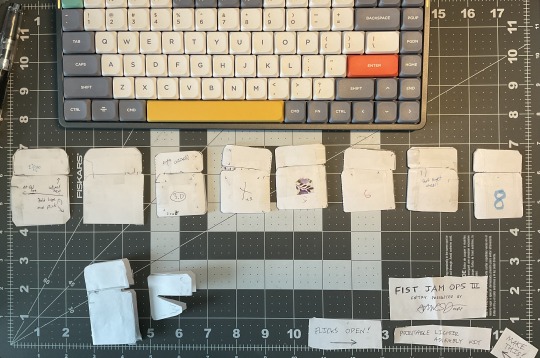
The lighter itself took about 8 distinct, fully assembled iterations to get right. In the photo above, you can see the very first mockup I ever made on the left and the final version on the right.
The lighter itself is only two pieces and the assembly process is relatively simple -- the part that I needed to iterate on so much was (perhaps unsurprisingly) the hinge. Finding a way to hinge two-dimensional objects using only folds and tape wasn't that hard, but finding a way to make it robust and consistent was a huge pain. If you make the hinge too loose, then the top part of the lighter would wiggle around too much. If you made the hinge too tight, then it was either too precise to cut or too stiff to flick open.
At first it might not seem like a big deal to make the hinge loose, but if it's too loose, then the top half of the lighter would slide out of place and cause the hinge to get stuck open or closed. It would also cause the lighter to have a generally sloppy silhouette, which annoyed me.
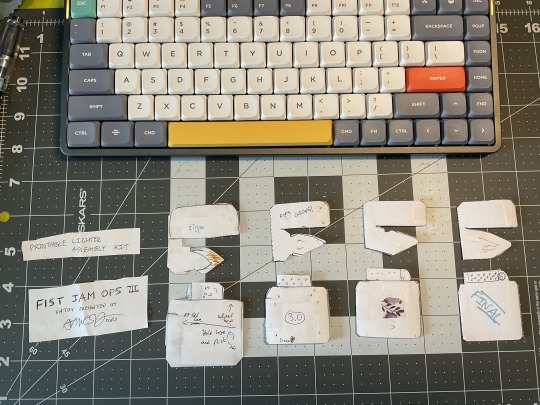
In the image above, you can see how the cutout between the flame and the lid of the lighter changed across the iterations. In the end, it needed to be as uniform as possible to prevent snags.
You can also see in the above image how the flame guard -- the protrusion from the bottom part of the lighter that the flame pops up out of -- had to change over time. Unfortunately it couldn't be scaled accurately to a real Zippo; It needed to be short so that more of the flame is visible and it needed to extend back into the lid when the lighter is flicked open so that the lid wouldn't get caught on it when you flick it closed.
I had a lot of fun working on this project and I have been encouraged by the positive response it has received among the FIST community. This is my first published TTRPG supplement and it won't be the last -- I have multiple projects planned in a similar vein that I hope to release over the course of the year. As of now, here are some of my ideas:
An expanded "smoking kit" with a lighter, matchbook, and box of cigarettes. Maybe a box of cigars too.
A "comms kit" featuring a cassette and tape deck, a pair of walkie talkies (with "talk" buttons that you can push down!), and a vintage cellphone (probably something inspired by the DynaTAC8000X)
A "wonder nines" pack with some of the coolest looking FIST-era pistols (namely the M9 Beretta, the P226, the CZ-75, and the P88)
A "classic pistols" pack with even more iconic FIST-era pistols (like the Glock, M1911, Deagle, and maybe a revolver if I can figure out how to make it)
I want each pistols pack to have 4 guns each so that every member of an average-sized FIST party can have one at the table.
If you have any questions or suggestions, you can reach me via the FIST Discord (I'm @Parkagirl#4918), email ([email protected]), or the Tumblr ask feature -- that's anonymous too, so don't be shy.
Until next time.
My FIST JAM OPS III entry is live, and just under the wire. Stay tuned for a postmortem blog entry soon!
14 notes
·
View notes
Text

OzTREKK Ambassadors: Figuring out your study workflow
All right! You’re done your first semester of your second year of medical school—you must really have your routine down by now!
Hahaha! Nooooo.
My routine has changed drastically from my first year of med school, and I’m sure it will change even more in the future when we move into clinical years. But here is what my day looks like, what tools I use, and what I’ve figured out so far. There is a lot more to medical school than just lectures and anatomy lab. Who knew?
Using Anki Maybe it’s because I’m a little bit older than the rest of my cohort, but I learned about Anki in my first year and it sounded awful. I was never the type of kid to make my own flashcards (on paper or cue cards back in my day) and I often mocked the kids that did. However, spaced repetition is proven to be a tried-and-true method of getting facts and concepts into your head, and keeping them there. I think what turned me off of it at first was making my own cards and not really being sure I’m covering all the information I needed to. Luckily the internet can help with that.
There are reddit pages dedicated to sharing, editing, and perfecting Anki decks for a variety of tests, specialties, and subjects. These pages have videos and guides on settings, good resources to pair with it, and how to use this tool. Essentially, for me it boiled down to using Anki decks for step 1, even though I have no intention of writing it, because these decks have been used, tweaked, and perfected by so many students before me, and simply doing cards that relate to what I’m learning. If you’re really lucky, previous students may have made decks for your specific curriculum. It can be a little bit of effort to make yourself go through these flashcards and figure out how to do it effectively, but you really get out what you put in. I often catch myself blurting out facts, almost unsure how it got into my head. That’s Anki for you.
Using the Pomodoro Method One tool I started using in the first year that has lasted is the Pomodoro timer, but how I’ve used it has changed somewhat over time. The idea behind the timer, at least in my head, is trying to trick your brain. I think to myself, “Okay, I’m going to do some work for thirty minutes. After that thirty minutes, I have permission to goof off for five minutes and watch YouTube videos about Rick and Morty. Then I’ll have to do another thirty minutes of work before I can goof off again.”
However, the thing that has changed for me is turning off the auto timer. The timer that I use has a setting to automatically switch from your work to your break once the notification goes off, or you can turn that off, meaning that your rest timer doesn’t start until you manually click over to the other tab and switch it over. It takes a bit of discipline to actually follow the guidelines; however, this means if I’m caught up in what I’m doing—like I’ve really gotten into a good workflow state—I can continue plugging away with what I’m doing and the constant buzzers of breaks and work periods won’t disturb me from the state I’ve gotten myself into. If I start to lose steam after accidentally working for 45 minutes instead of 30, then I know that I still have a five-minute break to goof off and reward myself a bit.
So, most days, if I don’t have obligations at school or in hospital (like labs, bedside teaching, or clinical skill workshops), I will spend the morning trying to work through all the Anki card reviews I have using the Pomodoro timer “method” I just mentioned. Once I’m done that, I will move on to new content for the day.
Check Your Notes Medical school in the time of COVID means that all lectures are done online and recorded for future use. So, that usually means waiting until the lecture is done, then watching it at 1.5x speed while using my iPad to annotate the slides and make my own notes. Jacqueline and I personally use the program Notability. It works great if you have an iPad and an Apple pencil, and you can physically annotate the notes as you go along. A lot of our classmates use other programs like OneNote to similar effect. Then, if I still need to brush up on the topic, or review it before next case for PBL, there are a lot of resources online that are great for showing you what’s high-yield information, such as Osmosis, AMBOSS, or textbooks like First Aid for the USMLE Step 1.
Getting Into Your Flow I try to do all of this by using the Pomodoro timer to break up the work throughout the day, but you also need to step away from your desk (or in our case, the kitchen table) throughout the day. Go for a walk, drink too much coffee, go to the gym, take a nap and watch a TV show. You need to allow your brain to turn off for a bit, and digest what you have been shoving into it. Schedule your breaks so you don’t get carried away, but make sure you actually schedule them.
What works for me, or Jacqueline might not work for you, but you won’t know what works for you until you figure out what doesn’t. If the first year of medical school has taught me anything, it’s that learning what doesn’t work is just as important as learning what does.
Levi
OzTREKK Student Ambassadors: Levi and Jacqueline Atamanchuk University: Griffith University Program: Doctor of Medicine Follow them on Instagram: @weddedmds
Check out Jac and Levi’s other articles!
Do What Works For You: Our motto for learning online
9 things to consider when weighing multiple medical school offers
Finding balance as a medical student during a global struggle
#medical student#study medicine#study tips#study motivation#griffith university medical school#doctor of medicine#MD students
1 note
·
View note
Text
Stop Motion: Evaluation
23/04/21
Evaluation
The Stop Motion project brief focused on the animation style of ‘stop motion’ and required you to use food items to create an animation with a total duration between 15 and 30 seconds, using relevant techniques. In preparation for shooting my animation, I researched the development of stop motion in films and watched a few of my favourite movies which used these techniques to get inspired. Through research, I became more knowledgeable on how these animations are created, the key rules to consider during the productions stages and also watched multiple tutorials on the production and post-production processes to familiarise myself with the software and tools that could be used.
I believe I have met the requirements for the brief as I have planned, shot and produced a stop motion animation that is 15-30 seconds long that includes food as the key subjects. The animation was processed and optimised using Adobe Bridge and Photoshop, by referring to video tutorials I was able to create a workflow process to create a final video and make use of the available tools in this software. The inspiration for the theme and content of the final animation stemmed from the theme of change and growth, which is a consistent theme in my work as I feel it is constantly relevant to real life. So, I felt that the process of metamorphosis that a caterpillar undergoes to become a butterfly would work well with my inspiration to portray change in a delicate and positive way and I decided to title this project “Metamorphosis”. I wanted the animation to be simple but detailed and I challenged myself more so by combining object motion and cut-out motion. Using pieces of card to create a branch to use as part of the background and painting this to create more texture and enhance the overall visual impact of the animation.
My strengths during this project were the research stage as I spent a lot of time looking into the history of stop motion and understanding how this developed as technology as software developed. Stop motion movies are my favourite style of animation so I was excited about working on my own so I watched a few of my favourites such as the Corpse Bride to help inspire me (also a refence to change, acceptance and butterflies within this film). I think that my thorough research into how these animations are actually produced was very useful and I made sure to go back are refer to all the tutorials I came across and make notes on the key factors to consider.
My weaknesses during this project were during the post production stages, however I feel they were more so obstacles than weaknesses. Despite watching multiple tutorials on how to work on video files in photoshop and create an animation, I ran into a handful of issues such as videos not exporting properly or tools not working. I worked through the same workflow process as shown by my technical class lecturer but after multiple attempts and after talking to a classmate I realised I had just missed out a stage which led to the exporting issues. So, after figuring out where I had gone wrong and starting the post-production process over again, I did manage to successfully create a video, add audio and export it to the required settings according to the brief.
Overall, I really enjoyed working on this project as stop motion has always interested me and this brief has given me a chance to explore this video style, develop techniques and a more in-depth understanding of how they are created. I also enjoyed exploring more of the tools and options within photoshop as it is a software that has huge potential and there are always more things to explore and experiment with. If I was to redo this project, I would just like to work in a better set up with use of a sturdier tripod as the one I own has a few faults, but they were easily worked around. I believe I have created a good stop motion animation for my first attempt, using story boards and tutorials to structure the project and adding suitable audio to enhance the final animation. I do plan on using these skills and techniques to create more animations in the future.
0 notes
Text
5 Ways That Any Ticket Sales Team Can Make More Sales...
Lately, I’ve been doing a lot more coaching, workshops, and webinars with sales teams at ticket selling organizations around the world and I’ve come back with a few ideas that can apply to every organization that sells tickets, experiences, or events.
Here are my top 5:
Ask the right questions.
Focus on quick wins.
Use previous results to show you the road to the next success.
Allow your numbers to show your impact.
Focus on action items.
Let me explain in more detail.
Ask the right questions:
Almost always, an organization engages me because they want to increase their sales or revenue.
This usually comes hand-in-hand with a hypothesis of what is the problem.
It could be something like “we need to get better at closing,” “can you help us create a stronger call-to-action?”, or something else.
Most of the time these hypothesizes are based on the pain that an organization is feeling in the moment.
You may not be selling as fast as you’d like so it must be your sales closing.
You are running around chasing too many ideas with no progress, must be you need to improve your workflow.
In a lot of cases, the answer is much simpler: in most cases, it comes down to whether or not you are setting the right priorities. Which often means you need to ask better questions.
A really helpful question I use often in my coaching or workshops is: “What are your top 2 or 3 priorities?”
You may only have 1 or 2. That’s fine.
The priorities are important because they allow you to ask an internal question that drives every action you and your team take which is: “Does this support my priorities?”
If not, you might consider doing something else or not taking the action at all.
This all begins by asking the right question.
Focus on quick wins:
In learning about becoming a better consultant, one of the most important lessons I’ve learned is that you need to give people some quick wins.
Why is this so valuable?
There are tons of reasons, but three big ones are:
People have heard it all before and aren’t buying this change effort.
Quick results make people feel good.
Quick results and follow-through lead to people buying in on tougher efforts.
What will a quick win look like?
Depends on your business, but I’ve had organizations I’ve worked with improve their year-to-year sales by 50% or more within 90 days.
I’ve even seen dramatic sales increases in as little as 15 days in certain cases and have some pretty great examples of organizations changing their culture with the right buy-in in under 30 days.
The better way of thinking about quick wins is to put them in this context:
Is the win measurable?
Is it obvious?
Can you easily celebrate it?
Use previous results to show the way to your next success:
In a lot of cases, we stay wed to what got us here for far too long.
At the same time, we can often not pay enough attention to why we were successful to begin with.
A way to drive sales is by figuring out why you were successful, what that means to your business, and how you can use this knowledge to drive more success for your business.
Here is an example that may be useful to you:
A few years back when I was first really establishing my consulting practice and starting to do more stuff remotely, I was hung up on the idea that I always needed to be in the person’s office I was working with to help them or that I couldn’t possibly sell consulting services over the phone.
I was wrong on all of those counts.
I realized that not being in someone’s office didn’t mean that we couldn’t talk on the phone, diagnose a problem quickly, and come up with some action items that moved the business forward.
In fact, it meant the opposite that because I was so responsive I could do more for my clients because we were focusing on the impact of our work and not time or location…just impact.
For your business, something similar might be at play.
Maybe people aren’t buying tickets because they don’t want them, but because they have a notion that tickets aren’t available, are too expensive, or some other reason.
I’ll show you an example of a negative that you can turn into a positive as well.
As an example, look at the Washington Nationals, there was a report in the paper that attendance is down significantly despite the team being the hottest team in baseball and one of the best over the last 5 or 6 years.
What does this tell us?
Winning doesn’t solve everything.
How does this highlight the road to future success?
Simple, knowing that people aren’t turning out just because you are winning means that you can throw out all of your old assumptions and try something new.
Like changing the packages you offer or changing the way you do email, or pricing, or whatever.
The key is to use the information at your disposal to help you make decisions that will lead you to your next success.
Allow your numbers to show your impact:
Sometimes we take action and we do it almost in a vacuum. Which leads to the situation where we don’t know if our actions had an impact or not.
This can be a pain for any of us, but when you are working in a larger organization or with a team, not knowing your numbers can be fatal to the cause of change.
Why?
Well, if you don’t have evidence to back-up your results how will you know anything is working?
You won’t.
And, if you can’t make a case for the change you’ve been creating, you are going to struggle to get people to buy-in to the next set of change that you want to make.
So show your work.
It is pretty simple:
Take a snapshot of where you started.
Check your numbers as you are moving forward.
If you are being successful, ask why and figure out how to double down on stuff.
If you aren’t, ask why not and figure out how to change.
The key here is to measure what you are doing and use the numbers to justify the changes you want to make.
As an example, I was partnering with a client that was trying to hit a new revenue result.
We came up with one simple change to be made across the business.
We measured the before and after 15 days, we compared it to the results prior to the change.
What happened?
We had an impact of mid-five figures in new profit in under 10 days.
Just as important, the morale of the team improved because they saw the positive impact of change take hold in a tangible way.
So measure and use those measurements to guide you forward.
Action items are your friend:
Peter Drucker used to say, “I’m glad you had a great time with me, but what are you going to do differently on Monday.”
I have a similar approach to my workshops and coaching calls, I’m glad we uncovered issues or refocused you, but if you aren’t going to do something differently as soon as we get off the line…I’ve failed and you’ve wasted your time and money.
At the end of my workshops and coaching calls, I make sure we have action items that do three things:
They are actionable.
They are measurable.
They are time-sensitive.
Why?
Because you need these pressures to create change.
Here’s an example:
Say you want to write a book.
A bad goal is to say as an action item: “I’m going to brainstorm book ideas.”
Why is this bad?
Because there just isn’t nearly enough there for you to feel compelled to do anything meaningful with your brainstorming session.
Instead, put it into my formula and it would come out: “I’m going to brainstorm book ideas and come up with 3 ideas that I think have a market fit and reflect my value proposition that I’m going to share with you by 9/5/19.”
It seems simple, but putting those kinds of pressure on your self will get things done.
How do you do that effectively for your team?
You might think about your priorities and think about what few things will improve your business immediately and build them into an action plan for your team.
Let’s say you want to sell more tickets through your marketing efforts, a great goal and action item might be:
“We are going to come up with 3 new ways to market our tickets and we are going to map out 3 action steps that we can take on each of them by the end of the day today.”
This does a couple of things:
Sets a clear goal for you.
Puts a time limit on you.
Opens the door to more actions.
Make sense?
I’ve been learning a lot from my coaching and workshop sessions and I’ll have more to share, but this should be a good jumping-off point for you.
Want a coaching session with me? I’m now offering small-group coaching sessions for sales teams and marketing departments to reset your focus, get your team focusing on the right opportunities, and taking actions that will deliver results. Want to learn more? Email me [email protected]
25 November in London, England: 1-day workshop called: “Revenue Reimagined: A The Business of Fun Workshop”.
In this full-day workshop, we will work through the how arts, sports, and events organizations can rethink and reimagine their revenue operations from selling more tickets to generating more membership sales, to selling more merchandise, and more. This workshop is a great way to kick off your strategic planning for 2020 and motivate you and your team to take new actions to create change in your organization.
Because this is going to be very hands-on, I’m going to limit this to 20 folks or less. So space is super limited!
To learn more, send me an email at [email protected] with the subject line “London”
Please follow and like us:

5 Ways That Any Ticket Sales Team Can Make More Sales… was originally published on Wakeman Consulting Group
0 notes
Photo
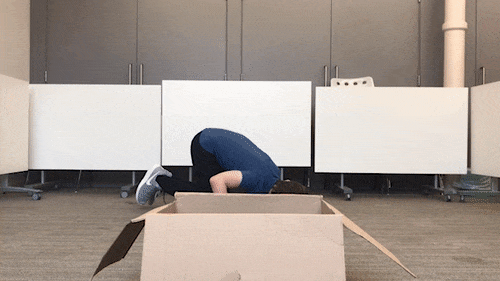
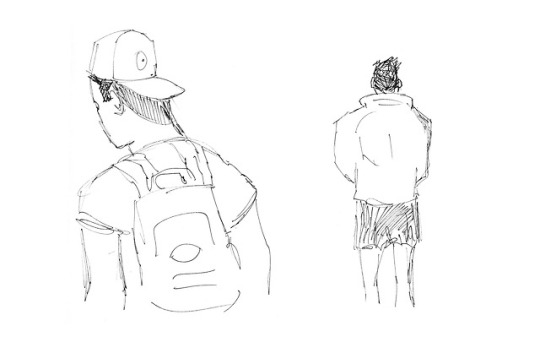

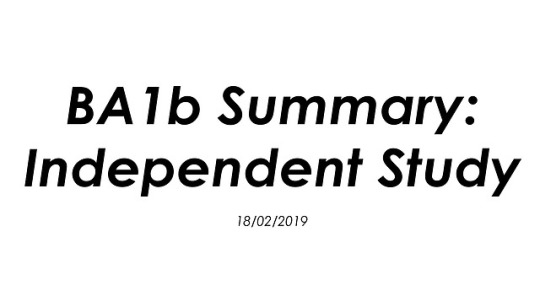
Overview This week, I placed a major focus on completing the practical assignments in preparation for submission next week. Having to juggle several projects at a time has been a challenge, though I feel like I’ve used my time wisely and efficiently in these last few weeks. Having taken the opportunity to complete my narrative research assignment ahead of time, this left me with the week before hand-in to complete any outstanding practical work. This was mainly completing my Guess the Film animated piece, and completing the sketchbook task. Additionally, to this, I took the time to produce some more reference footage for the Mystery Box project, exploring a less dramatic and more personal, character-based approach in the form of a ‘peek a boo’ game. As a whole, it’ s been a productive, intensive week for me but in the process. I have been able to create a motion design piece that I’m actually happy with and created some helpful video reference in preparation for animation.
Mystery Box This week, I took the time to produce some more reference footage for the Mystery Box project, exploring a less dramatic and more character-based approach through a father and son’s ‘peek-a-boo’ game. This allowed me to explore new, considered ideas in response to the brief and develop my understanding of key storytelling poses, appeal and timing before actually moving to the animation stage next week. With this, I’ve found an exciting and ambitious new approach to the Mystery Box project.
For this assignment, I want to challenge the preconceived standard ‘full-body shot’ of the brief and explore a more original and cinematic approach to the task, by effectively changing from a long shot to a medium shot through the character’s movements. My plan for the following week is to create a refined storyboard and animatic based on this reference and begin playing around with the animation workspace in Maya.
Animated Sketchbook This week, I was able to put a major focus on completing the ‘animated sketchbook’ assignment ready for submission: not only completing the sketchbook with drawings but challenging myself to create observational studies alongside my more original and fantastical sketches. This resulted in interesting, quick sketches that simply serve to explore my study subjects: presenting a series of face and figure studies.
There are some successful drawings on these pages, experimenting with both a pencil and fineliner to achieve different qualities of line. Each of my sketches possess a loose, erratic and scratchy quality and aesthetic that really lends itself to animation, I feel. Looking at my sketches, I found it exciting how I could see some interesting narratives developing, and the use of continuous line provided an exciting challenge to standard sketching. Ultimately, this drawing session reminded me why observational drawing can be useful and fun as an animator: we are drawing from life for ideas, but quickly scribbling these moments down for future reference. These sketches represent a warehouse of ideas to return to, and I actually found some value in this.
Looking back, however, I wish that I had continued and developed upon the idea of a ‘diary comic’ for this task. As a fan of comics myself, I feel like this would have made the brief more enjoyable. As a whole, though, I feel like I managed to complete the project and create some interesting character concepts in the process. I’ve been able to develop a few sketchbook ‘habits’ and will continue this practice moving forward.
Narrative Research Having completed this project last week, I spent the duration of this week focusing on my other two projects, readying each for submission.
Digital Principles This week, I placed a major focus on completing my animated sequence for the Guess the Film task. Over the course of the week, I underwent an extensive iteration process, exploring several ideas and developing off each one - spontaneously coming up with new ideas within After Effects to evidence a natural, evolving workflow. With this, I managed to produce a single sequence that I’m happy to submit for the deadline next week.
For this brief, I wanted to take my approach beyond the requirements of the project and create an animated sequence that allowed me to explore the ideas of motion design as an industry: taking the time to plan out my sequence, develop appealing vector illustrations for the sequence and consider how I can make the piece visually exciting. This is a key element in motion graphics: fluid, exciting movement but also considered, appealing visuals.
With the animation of the Alien Language, I wanted to exercise as many of the principles as I could: adding anticipation before each language forms, and follow through as the line over-shoots the swing. Before the ooze-like substance stretches out from the rings, I’ve made sure to add anticipation even in this small motion: to prepare the audience for what is going to happen. The ring itself isn’t static; it keeps squashing and stretching: this was an important idea to present to the audience, that this language isn’t a solid object and instead, a tangible, floating shape.
After showing the piece to my peers, I can see that the sequence has a visual appeal: my concentration on appealing design and aesthetic has resulted in a positive reaction from the audience. They enjoyed the simple, clean style to the illustrations and smooth movement. In particular, the geometric smoke garnered the most praise due to its ‘appealing, impressive fluidity’. There are a few particular frames that I feel are some of my most interesting design work to date, and work to not only represent my chosen film but be pleasing images and compositions of their own.
With this, I feel like I’ve been able to create an animated sequence that successfully demonstrates an understanding of the basic principles of animation, and presents a visually appealing metamorphosis sequence that is able to evoke the themes and visual imagery of my chosen film, Arrival. Whilst I have taken a more experimental, exciting approach to this task making use of virtual cameras and three-dimensional layers to add a sense of depth, I feel as if I have successfully met the requirements of the brief.
Despite this, I’m very interested in developing this piece further, beyond the limitations of the brief. After discussing with my peers and conducting my own research into the industry of motion graphics, one key element is the inclusion of texture: this adds to the visual appeal of each design and works to lend a hand-crafted warmth beyond the minimal, vector aesthetic. For elements such as the Window, and the Shell itself, I would like to explore this idea in more depth. I’ve really enjoyed this project, and as an independent development, I plan to explore the use of an animated grainy texture in my own time - further developing the piece, and embracing the practices of the industry.
#ba1b:narrativetheory#ba1b:digitalprinciples#ba1b:weeklysummary#ba1b:animatedsketchbook#ba1b:mysterybox
0 notes
Text
documentation of psychological changes: talking about schoolwork, medication, weed, therapy type things
Re-evaluated courseload and dropped the really difficult required one. Spent half an hour getting increasingly stressed, reorganizing courses along three different options – what's my schedule for the next three quarters if I take this (difficult but not as difficult, less interesting) other required course instead? what if I take a fourth quarter? What if I try to take it this quarter anyway? Reasoning that I could identify by the most desirable/reasonable future and stick with that one's schedule. Was a third of a way to tears when I left for the easier class that I hadn’t decided then to replace my hard class with.
On the physically unpleasant, angrily-squinting-against-rain bike ride to class, I first had a couple minutes of thinking about unrelated stuff (philosophy) but with the same unhappy frantic pace of thought, and then my brain kind of calmed down and said, look, this class I'm heading towards is something I want to take, the class I'm dropping is also something I want to take, I'm stressing out because I want to fit in all my requirements to graduate as soon as possible, but is that really how I want to do school? I've prepared over break to start this quarter at a sprint and get a lot out of it – I'm finally in a place where I have the ability and mindset to really get something out of school. Why am I in such a hurry to leave – should that be a priority?
...and it was clear from about a couple dozen seconds of thinking that the answer to this was no, for me. So, all right. I'll take an extra quarter. I want to take an extra quarter. There are things I want to do and have irl that aren't compatible with school, but I'll get to those. The anxious voice that says "yes but shouldn't I –" is... not something I need, once I've come to that conclusion.
So. That's nice. This is also the kind of thinking that I was plain incapable of six months ago. This way of stepping back and actually figuring out what's important and what I really want to do. I have a similar new ability where I have a super unproductive line of thought and I can usually kind of bat it away because it is super unproductive. I did it last night while I was worrying about my units – I need to sleep now, this is something to deal with next morning, I'll stop thinking about it.
I have a better general ability to identify and think and do what is good for me. Where did this come from?
It definitely started when I got on Ritalin, which has feel-good effects, and I remember this kind of... sudden clarity / better knowledge about tasks and values and objectives. Like which ones were important. Which ones could be done how. When everything was undoable and hopeless it was one uniform dense list of stuff that was unsatisfactory in my life and I had no real intention of changing anything on it because it was undoable and hopeless. When they started being doable they started having gradations. That was the first thing. The second was that I started being invested in my happiness – like I want to graduate at my leisure* because I want my education to fulfill me or something, and I have expectations for myself as someone who's majoring in computer science that haven't been met yet with the classes I've taken so far, and graduating three months earlier or later really doesn't make a difference on the timescales I've started to think of my life in. Six months ago I wasn't capable of thinking about my life a decade from now. Life was just something that happened to me; where the waves buffeted me was their business.
*furious leisure, of course
An odd second chemical factor is marijuana. Weed is, broadly, not good for me. It's way too easy to use when I'm stressed, it makes me noticeably unsocial for about twelve hours, and I don't intend to have any around me this quarter. I did not use it in any productive way before starting Ritalin. When I'm on it and Ritalin – not necessarily at the same time, just when the windows of influence are overlapping – about half of the time, I'm doing some sort of behavioral therapy to myself all the time. Really obvious babying stuff that used to just annoy me when sober. "Is thinking about this subject stressing me out? I don't need another justification to switch to another topic." or "Huh, I have this unpleasant emotion, can I figure out why?" or "I notice I regularly do this thing that has a bad effect. I should stop doing it / find a way to do it less." in this very singleminded, no-dithering way. And I write a lot when high, so I record all this and actually do follow through.
I think I've cumulatively spent about ten to fifteen hours doing this kind of self-therapy while mildly high – two thirds of it last quarter, one third of it in the past week. When I started doing it last quarter, it was not directed or intentional – I was on a low dose of Ritalin, I was behind on work, I would fail to concentrate on or understand my work for a few consecutive hours and get so unhappy that I wanted to be unconscious, but since I wasn't sleepy I would get high. And one time while high, I noticed that I was unhappy. Which I had noticed before, it was really obvious. But I noticed I was unhappy in large part because I was high and procrastinating. And I wanted to be happy, which felt like a really new thought. So I should structure my life and space and habits so that was easier. I opened up a text file and brainstormed things I could do to improve my workflow, and strategies I could try before getting high if I was miserable in the evenings. And I explicitly wrote that I should forgive myself if I got high again when it was a bad idea, because I was noticing that blaming myself for that never actually worked for preventing it next time and just made me feel shitty. And I was tired of feeling shitty.
A week later, I was high again but even more miserable (school wasn't going well) and I just reevaluated how much good having weed around was doing me, decided my emotions about it were too obsessive, and I threw all of it out. It was great. I took out the trash kind of calmly and joyfully, knowing this was the last time in a while I was going to be high. The quarter didn't go great after that, I took a leave – not a choice I made without ambivalent, but I did make it clear-headedly and it turned out to be a great idea.
I acquired one cartridge in Washington my last week – before I did so I prodded all the "is this a good idea" (and follow-up "am I lying to myself") buttons, and the answer I got in the end was "not the greatest idea, but my thoughts around it don't have that obsessive edge they have when I'm trying to use it to escape the horribleness of everything, and I definitely miss the kind of creative writing I do on it. I am okay if I don't and okay if I do". I brought it back with me and used a small amount because I was having trouble with my appetite and I was getting legitimately worried about how little I was eating. I hate this cycle of okay use flaring into bad use when I'm under pressure, and I get dramatically more out of vaping when it's actually a choice, so I'm handing the cartridge off to a friend tonight, but I really appreciate how easily and... healthily... I made the decision about my courses today, and I think having vaped some yesterday for dinner was a factor. Or more specifically, the six or so hours of aggressively positive/productivity-focused thinking that dominated my thoughts before I went to sleep.
Some miscellaneous thoughts.
I don't know how to quantify how much good those cumulative hours have done me. A lot of them were intense hours, in that I was doing something in my head that I had never done before, i.e. root out undesirable thought patterns, beliefs, habits, strategies, and values. I'm pretty sure hour for hour they were at least ten times as useful as any therapy I've ever done, and they were twice as useful as the best therapy session I can imagine. I may have naturally done this more slowly, as a background process, if I'd never brought marijuana into it. But I've also heard the best stuff is therapy of some sort plus the correct medication. I haven't been getting great literal therapy, and I think it would be odd if I became this well adjusted in six months on the effects of medication alone.
Usually it's LSD or MDMA involved when people anecdotally talk about ameliorating their badbrains with self therapy on drugs or with a friend who knows what they're doing. Maybe those are good for having revelations or doing more heavyweight judo with your emotions? I am not sure.
I am never going to laugh at a self help book again.* I think self help books look silly to people who doing fine with life, even sillier to people to people who are doing badly and have wrapped themselves in a dozen layers of irony and resignation, and revelatory to people who are doing so badly that they'll do anything to make their life be something else, even take with the utmost seriousness stupid truisms about forgiving yourself for your mistakes and being nice to everyone and taking a walk every day. I think I got to type three without hitting any really bad life obstacles and am somewhat surprised I did so, because this is the sort of life turnaround I expect in narratives about middle-aged people. I expect to slip occasionally, but I'm genuinely pretty dedicated to making good decisions, in the way I used to jokingly laugh about other people (not me) doing, without any intention of emulating them. I mean good decisions with relationships of all sorts, schoolwork, jobs, intellectual growth, sex, drugs. And I will make these good decisions with the kind of flabby-sounding, cheerful, unfunny sincerity, even if part of me is grinding its teeth a bit, because the alternative is being unhappy and I am tired of that.
*David Foster Wallace's ghost, on the other hand, is never going to stop laughing at me.
11 notes
·
View notes
Text
From high school genius to software developer at Modex: Ion Orins
Behind Modex’s blockchain-based products and services there’s a young team driven by innovation. A team with cool people passionate about everything they do, people who get to play with the latest technologies in their quest to disrupt various industries and bring about change to the society we live in. Ion Orins is one of these people and his story should be an example for every young developer.
Winner of several digital creativity contests, Ion Orins (19 years old) is currently in his second year of studying Computer Science at the University of Warwick, UK. He has chosen this university for its invested involvement in research, even at an undergraduate level. Ion started learning programming in high school and immediately felt a connection with this subject. His belief that computer science was the right choice has been swiftly reinforced when he participated in a few programming related competitions after the first year of high school.
Ion is one of the two developers behind SmartScope, a project which focuses on convolutional neural networks with the aim to improve the user experience of a conventional optical machine. SmartScope Micro is a microscope based on Artificial Intelligence which classifies the nature of the analyzed material, while SmartScope Macro is a telescope which utilizes the concept of Machine Learning to detect and highlight, in real time, the trajectory of celestial objects. The SmartScope project can also be used in other domains such as biology, medical sector, etc.
How did the Modex story start for our Romanian colleague Ion? “I arrived at Modex just about two years ago. I participated in a hackathon, and one of the judges, who was working at Modex, invited me to do an internship at this company. After a while, I was employed as a part-time developer. My time at Modex has been defined by an array of complex and interesting projects related to a diverse range of areas in software development. During the internship I worked on testing a component of the Modex infrastructure. The next task I engaged in was creating a crop pest detection algorithm using computer vision. After that, I worked on creating an anti-money laundering algorithm for Moneymailme, a money transfer and chat app. Currently I am involved in the development of the PSD2 component in Modex’s banking project together with a team of programmers.”
When asked about the work environment at Modex, Ion says that it’s an energetic, open, and dynamic environment. “Everyone is willing to help each other. Optimising the efficiency of the workflow is often key, as efforts in this direction are being made continuously. The management is heavily involved in promoting both professional development and team building: meet-ups with outsiders, trainings and conferences are far from being unusual.” With offices in London, Bucharest, and Silicon Valley, Modex provides a dynamic, diverse and inclusive workplace, with equal growth opportunities to all of its employees, regardless of nationality, age, skin, colour, religion, gender identity and expression or sexual orientation. Fairness, respect and commitment are core values which can be found in the company’s philosophy. Besides a creative work environment and multiple personal growth opportunities, Modex encourages its employees’ initiatives and fully supports them in achieving their personal and professional goals.
“The one thing that fascinated me the most while doing the internship was finding out how professional relationships work. The dynamics of a work environment, especially of a start-up, as Modex was back then, were utterly different from anything I have experienced or could have imagined before”, says Ion when speaking about the most important things he has learned at Modex. The internship helped him evolve professionally, but also on the personal level. “First of all, the internship helped me obtain the necessary experience that I needed when I got employed. Secondly, it gave me the confidence that I have chosen the right path and offered me opportunities to meet people that I am currently learning many things from.”
Ion adds: “Modex is a young tech company that likes to experiment with new technologies and has invested in educating both developers and people without tech experience about their uses and benefits. One of Modex’s impressive accomplishments is the Blockchain Database (BCDB), a database which stores data in a safe and trusty blockchain system. In particular, I consider its use in the eConsultare.ro platform quite remarkable, as it allows a form of online voting, while reducing the risk of fraud, and is, quite frankly, a first step in the right direction of democratising the making of public decisions and imposing a degree of transparency inside public administrations.”
If there’s one thing Ion is very passionate about, that’s Artificial Intelligence. We’ve asked him to tell us more about the projects connected to AI he has worked on, and how can AI help us – individuals, but also the society, as a whole – in the future. “I have mainly been working on computer vision related AI applications, as I find it straightforward to demo and easy to engage with. I believe that AI’s main use-case in the near future is making technology more seamless, easier to figure out and interact with, which might be in a stark contrast with the fact that AI is usually considered as one of the more evolved forms of technology. A few related examples that are prevalent even nowadays are personal assistants, recommendation systems and noise reduction technologies, which ironically the better they are, the less noticeable they become.”
Firmly planted in today’s tech environment, Ion also keeps an eye on what lies around the corner. How does the future of blockchain, FinTech, but also AI looks like for our colleague? “I believe that the public sector will benefit the most from blockchain, as it relies on trust, and blockchain is a generator of trust. Regarding FinTech, it is already a very important tool used by many, including myself, on a daily basis and will most probably continue to become more and more popular and versatile. AI’s future could be a bit more complex. The methods used today in machine learning, which is currently the most popular form of AI, imply a number of ethical concerns and dilemmas. It has been more often than comfortable remarked that machine learning algorithms show the tendency to have the same biases and fallacies as us humans, and that their ethics are not as straightforward as we would like to think. However, this kind of technology has nearly infinite potential and its benefits will most definitely outweigh the efforts sunk into creating ethical AI.”
We’ve finished our chat with Ion by asking him to offer a recommendation to young people passionate about technology who want to get an internship or a job with a tech company. His advice was brief, and to the point: “Take opportunities, don’t be afraid to try new things!”
The post From high school genius to software developer at Modex: Ion Orins appeared first on Modex.
0 notes
Text
Autofocus Technology is Changing, Here’s Why It’s Not Just Bells & Whistles Anymore
We’ve all heard this argument before: “My current camera gear works fine, so why should I care about new camera technology?”
It’s a common counter-argument when debating if a photographer should upgrade to the latest camera technology, or even pay attention to it. Some photographers scoff at any feature they deem to be nothing more than “bells and whistles”.
While “if it ain’t broke, don’t fix it” is certainly an intelligent, logical argument to make, every now and then something does come along that is so big, it changes everything. And if you don’t at least follow along and pay attention, you may really miss out as a photographer, or, as a camera manufacturer, you may get left in the dust.
Nikon F3 AF, one of the earliest cameras to offer autofocus technology (Now that’s a huge viewfinder!)
For example, when cameras first gained autofocus capability, that was big. In fact, it was one of the biggest milestones in the history of cameras. However, believe it or not, most serious pros scoffed at the idea, at first.
Pros thought autofocus was a terrible idea; they believed manual focus was the only way to reliably capture professional quality results. And for a while, they were totally right. AF technology was terrible, at first. But it got better, and eventually, it was the only way to capture certain types of photos, images that would have been extremely difficult to capture before. Now, many photojournalists, action sports photographers, and wildlife photographers can’t imagine working without autofocus.
Well, things are about to change, once again. Not in such a massive way as the invention of autofocus itself, but in a more complex, advanced way. I’m talking about the whole new way of thinking that goes with the new autofocus technology available in cutting-edge mirrorless cameras, and yes, even in some DSLRs’ live view.
Face-detection. Eye-detection. Touchpads. frame-filling AF point spread. And, my personal favorite: nearly zero AF microadjustment!
Canon EOS R, Canon RF 50mm f/1.2 L | 1/320 sec, f/1.2, ISO 1600 (Full EOS R Review Here)
Previously, I would have never trusted an f/1.2 prime lens to nail focus on a dark, active dance floor. Now, I feel like I trust face-detection autofocus more than I ever trusted DSLR autofocus on a dance floor. (On Canon and Sony, that is. I haven’t tried Nikon’s Z-series face-detection at a wedding reception yet, that’s coming soon!)
Canon EOS R, Canon RF 50mm f/1.2 L | 1/320 sec, f/1.2, ISO 1600
Bottom line: I’ve never seen so many in-focus shots at f/1.4 and f/1.2, as I have with the latest generation of mirrorless cameras and native lenses.
Eye-detection autofocus has proven to be even more “nuts” (that’s a scientific term; it means shockingly good) when it comes to nailing focus at super-fast apertures, even in bad light. Within 1-2 camera generations, I envision myself using a completely different workflow to nail focus on wedding and other types of portraits, whenever a subject is holding relatively still and facing the camera. Eye-AF (Sony’s technology) is just so good, the keeper rate is far better than any previous focusing tricks or methods that I used on my DSLRs.
And, as I’ve mentioned in my reviews of the various full-frame mirrorless cameras in the last year, for the average photographer, any small advantage that DSLR autofocus may have in certain conditions is overshadowed by the simple fact that I’m finally free of my AF nemesis: fine-tuning, AKA microadjustment. Good riddance!
Sony A9, Sony 70-200mm f/2.8 GM | Expandable Flexible (Small) Point AF
Yes, the technology still has some wrinkles to be ironed out. Yes, a flagship DSLR still has superior focusing capabilities, in certain lighting or with certain types of action. But like I said, for the average photographer, and even for most working professionals, the balance has definitely tipped in favor of on-sensor, next-generation autofocus technology.
Any camera manufacturer that delays in at least figuring out this technology will be missing out on the next generation, the new mindset behind how a camera operates. Using a touchscreen to control the AF points feels so intuitive now, I actually wish they’d replace the tiny little AF point joystick with a slightly larger pad that accepts both button-push type and touch-sensitive input.
Firmware & Software Updates For Cameras
One of the major changes in this regard has been the recent trend among a few camera makers recently: the trend of adding significant improvements, or even totally new features, to a camera, via a free (or sometimes paid) firmware update.
The Sony A9 just received a huge, free update to its autofocus technology, enhancing the subject tracking and Eye-AF capability. Eventually, the same or similar updates will be available for the A7III and A7RIII.
The Sony A9’s AF update is so impressive, I’m surprised they didn’t charge money for it! It’s like a secret free mod pack for your camera.
This type of competitive, tactical move by Sony will be a very welcomed one to existing camera owners, and it will also hopefully encourage competitive behavior from other camera makers. Indeed, in the past both Canon and Nikon have done “major” firmware updates, and there are already rumblings that they’ll be taking things up a notch with their full-frame mirrorless systems too. Canon and Nikon have already announced updates to their EOS R and Z7/Z6 cameras’ autofocus systems (respectively), but they could be even better in the future.
youtube
Sony Real-time Tracking will mark a whole new generation in AF tracking
Firmware & Software Updates For Lenses
In addition to software/firmware updates that significantly improve the autofocus capability of a camera body, we’ve also begun to see small improvements and compatibility troubleshooting, for lenses themselves. It used to be that a lens was just an optic, and the camera was in charge of everything. Now, the lens communicates with the camera, and provides all kinds of information to the camera, and in some cases, can even make decisions related to focus accuracy.
For example, a recently announced update to the Zeiss Batis 40mm f/2 offers improvements to autofocus when using Sony’s impressive Eye-AF technology. Also, it instructs the lens to automatically stop down the aperture when focusing extremely close, to avoid a loss of sharpness and to increase depth of field.
The Eye-AF improvement will likely be very welcome to anyone who is using a current-generation Sony A7-series camera, or the Sony A9.
A Totally New Way Of Focusing
In the last 15 years alone, the number of autofocus points in a camera has gone from 5-7 to 500-700. The number of autofocus options has gone from “single” or “continuous” to, well, an array of options so numerous and complex that I could spend an entire article explaining the different autofocus options and features for each brand of camera.
Many photographers are already re-training their brains to use the rear touchscreen to move their AF point around the viewfinder, instead of a tiny little “joystick button.” The Joystick button was incredibly useful when your camera only had 9-11 AF points, but now that it has hundreds, moving the selected AF point around is going to require a whole new way of thinking.
Wide AF point coverage is a major advantage for full-frame mirrorless
Some photographers have significantly reduced the amount of “moving the AF point around” entirely, by relying much more on a larger AF point zone, and face-detection or eye-detection autofocus features to nail focus in portraits, which has begun to be a truly superior way of shooting in the last few years. Both Canon and Sony’s on-sensor autofocus, even in DSLR form on the 5D mk4, are uncanny at “tap to focus” face detection when shooting in live view.
Conclusion
So, here’s the bottom line, folks: technology is going to keep marching forward, and pretty soon certain technologies which we dismissed only yesterday as “professionally unacceptable” or “not better than what I’ve currently got” will all of a sudden be far superior to the current methods we know.
In fact, many photographers who are more comfortable being early adopters than I am have already come to rely on things like face-detection and eye-detection in their autofocus, and this whole article may be old news to them! As a more “play it safe” photographer myself, though, I am here to say that this bell & whistle is here to stay.
from SLR Lounge https://www.slrlounge.com/autofocus-technology-is-changing-heres-why-its-not-bells-whistles-anymore/ via IFTTT
0 notes
Text
Doing diligence on a potential acquisition
When they buy a company, investors are betting the story they’re told is accurate, that it fairly represents future opportunities and risks. They’re betting on management – the people who built the company, that they’re who they appear to be – honest, insightful, decisive, well-connected.
When they get it right, it’s rewarding indeed. But when they don’t, it may be career-limiting.
Investors do diligence – often a lot of diligence – to make those bets as sure as possible. But, most investors aren’t expert in the specific niches occupied by the companies they are buying, so they rely on “Subject Matter Experts.” These are long-time industry people who know the ins and outs; probably know the business and its management; understand markets, regulations, and where things are headed; and have the contacts and relationships who will help give them the real story.
In the ten years or so I’ve been doing this, I’ve learned a lot. Here are a few takeaways.
Dig Deep into the Details
The proof is in the details. Dig deep into the stuff that drives the financial results. Investors are really good at financial analysis, but they don’t understand what drives those finances. Things like procedure codes, billing processes, discount arrangements, fee schedules, workflows and systems connections are where the business succeeds or fails.
Example – Read the actual provider contracts. What do they cover? What are the rates? What is the time frame? Compare the contracts to those provider’s bills – do the billing results match the contractual terms? Is the patient a member of a contracted customer? Did the customer do what was required to “earn” the discount?
If the seller won’t get into those details, you’ve got to ask why. Either A) they don’t have that information available, which is troubling in and of itself, or B) they have it but don’t want to share it, which is also troubling, and/or C) they are paranoid their “secret sauce” will become not-so-secret.
Push, and push hard. Make very sure your client knows exactly why this information is critical.
Pay attention to…
Overnight successes. Businesses that sort of float along, then experience a sudden jump in profits and/or revenues need extra-careful analysis. The seller will claim this was all part of the plan, they built carefully, invested heavily, and now are seeing the benefit of that strategy.
Perhaps…and perhaps there’s been some deep cost-cutting, a change in how they determine what’s revenue and when they can recognize it, a shift in accounting for old receivables, a new billing process. That’s not to say those things are inherently bad, they just may not reflect anything more than a one-time bump, or they may not be sustainable, and/or their suppliers (in many cases these are healthcare providers) may decide they don’t like whatever’s changed.
Vague claims. Stuff like “we keep all our customers”, “our program is clinically based” – where’s the supporting documentation? If the seller says it, they should be able to back it up convincingly.
The SME’s job
The seller will do a fine job of “selling”, my job is to be the realist.
In my view, my job is not to blow sunshine up the buyer’s shirt, but rather to find the potential issues, problems, roadblocks, and concerns and clearly illustrate what they are, the potential implications, and how much of a problem they represent.
There’s a lot of pressure on investors to do deals. They’ve taken millions of investor dollars into their funds, and need to park it somewhere. As potential deals become scarcer and more expensive, the pressure increases.
Strive to be just a bit on the skeptical side, and you’ll serve your client well.
Stick to what you know
I’m often asked “would you invest your money in this business?” To which I reply, “Look at my investment portfolio and you’ll see why I’m the wrong person to ask about investments.”
Point being, buyers value companies for reasons that escape logic, or at least what I think of as logic.
For example, there’s CorVel. Why this company has a price:earnings ratio of 30 is beyond me. Revenue growth is minimal, operating income grew 10 percent in 3 years…hardly a growth company worthy of that multiple. But hey, what do I know.
Instead, focus on the business itself – let the investors figure out what it is “worth” – they understand valuation, I don’t.
Be clear about your biases
As you know all to well, dear reader, I have strongly held opinions. You should too. Be very careful to support your opinions with facts, based on data, supported by logic. Be transparent to your client.
That doesn’t mean you don’t share your views, just be clear about what they are, and on what they are based. That allows the client to assess how they should value your view on that issue.
One advantage of spending decades in a business is you just know stuff, you see things and instantly have a sense that this is BS, or wow, this is innovative, or huh, that doesn’t look right. You can’t exactly put your finger on it, but it’s there.
Your client is paying you for those decades of experience, the judgment it brings, and must know how you arrive at a conclusion, statement, or opinion. Telling the client that something just doesn’t feel right is fine – but understand they’re going to push you hard to figure out why.
Tomorrow, a couple other things I’ve learned
What does this mean for you?
It’s critical to be critical.
Article source:Managed Care Matters
0 notes
Text
A New Category King Emerges in Marketing Automation, and a Founding Member Interview
I’ve written about category kings before: it’s what every startup should be striving for.
There’s one unquestioned “Category King” in real estate. Among real estate portals (in the US), the clear, runaway king is Zillow Group.
There will be “Category Kings” of various segments of the industry, and I think we’re seeing one of them emerge.
Imprev, in marketing automation.
The Imprev platform already powers the marketing centers for hundreds of brokerages and franchises—representing over 20% of real estate agents in North America—including RE/MAX, Coldwell Banker, Berkshire Hathaway Home Services, Corcoran Group, NextHome, Realty World, and Hunt Real Estate, as well as Homes.com and MRIS.
You may have seen the recent Imprev partnership with NextHome, a real estate franchise with 290 offices and over 2,400 agents. The company also owns the Realty World Northern California & Northern Nevada franchise networks, collectively controlling over 400 offices and more than 3,000 agents. The company closes over 14,000 transactions annually worth over $4.6B in volume, and is more often than not one of the companies in contention when brokers/agents are considering a change of brokerage (see here).
In the press release, James Dwiggins, the NextHome CEO, says “We’re Raising the Bar in Real Estate Marketing”. That obviously implies that Imprev’s platform is helping facilitating that. To me, the Nexthome deal marks a major notch in Imprev’s quest toward domination of marketing automation in the real estate industry. We’re at the point where if you’re in this industry and realize you need marketing automation, there is no real question as to who the leading provider is.
Founded in 2001, Imprev is an example of a company that remains in the slow and steady wins the race camp. That’s my type of business. They aren’t flashy. They don’t overpromise. They don’t care if they are on stage. They plug away with improving their product and increasing their sales one day at a time. Every single day, month after month. Year after year.
Congratulations, Imprev. Welcome to the throne as the category king for marketing automation in the real estate vertical.
I’ve known their CEO, Renwick Congdon, for a number of years (see his meet the RE tech entrepreneur interview from last year). He’s a class act. We’re fortunate to have him as a founding member of the Geek Estate Mastermind. I had the pleasure to ask him a few questions to dig more into their recent work and where he sees the industry heading.
What’s Your most significant business focus for 2018?
Helping brokerages and franchises build stronger relationships with their agents through marketing automation. Marketing automation helps the broker act as a “marketing guide” for their agents and systematizes best practices to make everyone more successful. This is a key service where the broker can offer tangible value to their agents. For example, marketing a luxury home in Los Angeles requires different steps and workflows than a starter home in Indiana. The broker has the benefit of looking at all the company’s listings and pinpointing trends, successes, and failures, then using that knowledge to automatically recommend the next best steps to not only market a new listing, but to use that marketing to generate more business. That type of support is powerful!
When did you originally realize marketing automation was where the company would make its mark, and what’s been the hardest part of fulfilling your vision?
Since 1992 when I wrote my first marketing software program—before I started Imprev—I’ve had the vision of handing real estate agents all the marketing materials they need to promote a listing and their business. The hardest part has been waiting for technology to catch up. When I started Imprev in 2000, our technology was able to deliver functionality that few other companies could match. Agents could create all their materials, from flyers to flash multi-media, within a very easy user interface, and they had access to hundreds of professionally-designed templates.
In 2015 we felt the technology to create all the design work for agents automatically was ready for scale. We launched our first client on automation, Berkshire Hathaway HomeServices Fox & Roach, REALTORS®, and haven’t slowed down since. Today we have 212,000 agents experiencing marketing automation and are generating millions of pieces of marketing across print, digital, social and video.
What’s next for marketing automation?
Continuing to help brokerages and agents generate more business from the listings they already have on a larger scale. Opportunities include leveraging the vast amounts of data out there to automate hyperlocal marketing for agents. I find that idea really interesting. The portals have a tight grip on the consumer right now; how can we change that and give some of the power back to brokerages? I believe that automation—used correctly—will bring agents and brokers closer to the consumer. Every day we’re expanding the scale of what automation can handle.
What real estate technology trend or product are you most excited about?
Artificial intelligence. I see AI as telling the computer the rules, and letting it figure out the options, versus machine learning, which just shows the computer a bunch of experiences that it can choose from.
What do you like about being a Geek Estate Mastermind member?
Connecting with really smart people about cutting-edge topics. Drew brings up subjects that are so far advanced; it’s a great reminder to keep an eye on the future and make sure we’re prepared for the next big thing.
Geek Estate Mastermind
Apply for Membership
[Graphic via https://www.colourbox.com]
The post A New Category King Emerges in Marketing Automation, and a Founding Member Interview appeared first on GeekEstate Blog.
A New Category King Emerges in Marketing Automation, and a Founding Member Interview published first on https://greatlivinghomespage.tumblr.com/
0 notes
Text
Category Kings, Marketing Automation, and a Founding Member Interview
I’ve written about category kings before: it’s what every startup should be striving for.
There’s one unquestioned “Category King” in real estate. Among real estate portals (in the US), the clear, runaway king is Zillow Group.
There will be “Category Kings” of various segments of the industry, and I think we’re seeing one of them emerge.
Imprev, in marketing automation.
The Imprev platform already powers the marketing centers for hundreds of brokerages and franchises—representing over 20% of real estate agents in North America—including RE/MAX, Coldwell Banker, Berkshire Hathaway Home Services, Corcoran Group, NextHome, Realty World, and Hunt Real Estate, as well as Homes.com and MRIS.
You may have seen the recent Imprev partnership with NextHome, a real estate franchise with 290 offices and over 2,400 agents. The company also owns the Realty World Northern California & Northern Nevada franchise networks, collectively controlling over 400 offices and more than 3,000 agents. The company closes over 14,000 transactions annually worth over $4.6B in volume, and is more often than not one of the companies in contention when brokers/agents are considering a change of brokerage (see here).
In the press release, James Dwiggins, the NextHome CEO, says “We’re Raising the Bar in Real Estate Marketing”. That obviously implies that Imprev’s platform is helping facilitating that. To me, the Nexthome deal marks a major notch in Imprev’s quest toward domination of marketing automation in the real estate industry.
Founded in 2001, Imprev is an example of a company that remains in the slow and steady wins the race camp. That’s my type of business. They aren’t flashy. They don’t overpromise. They don’t care if they are on stage. They plug away with improving their product and increasing their sales one day at a time. Every single day, month after month. Year after year. I’ve known their CEO, Renwick Congdon, for quite a few years (see his meet the RE tech entrepreneur interview from last year). He’s a class act. We’re fortunate to have him as a founding member of the Geek Estate Mastermind. I had the pleasure to ask him a few questions to dig more into their recent work and where he sees the industry heading.
What’s Your most significant business focus for 2018?
Helping brokerages and franchises build stronger relationships with their agents through marketing automation. Marketing automation helps the broker act as a “marketing guide” for their agents and systematizes best practices to make everyone more successful. This is a key service where the broker can offer tangible value to their agents. For example, marketing a luxury home in Los Angeles requires different steps and workflows than a starter home in Indiana. The broker has the benefit of looking at all the company’s listings and pinpointing trends, successes, and failures, then using that knowledge to automatically recommend the next best steps to not only market a new listing, but to use that marketing to generate more business. That type of support is powerful!
When did you originally realize marketing automation was where the company would make its mark, and what’s been the hardest part of fulfilling your vision?
Since 1992 when I wrote my first marketing software program—before I started Imprev—I’ve had the vision of handing real estate agents all the marketing materials they need to promote a listing and their business. The hardest part has been waiting for technology to catch up. When I started Imprev in 2000, our technology was able to deliver functionality that few other companies could match. Agents could create all their materials, from flyers to flash multi-media, within a very easy user interface, and they had access to hundreds of professionally-designed templates.
In 2015 we felt the technology to create all the design work for agents automatically was ready for scale. We launched our first client on automation, Berkshire Hathaway HomeServices Fox & Roach, REALTORS®, and haven’t slowed down since. Today we have 212,000 agents experiencing marketing automation and are generating millions of pieces of marketing across print, digital, social and video.
What’s next for marketing automation?
Continuing to help brokerages and agents generate more business from the listings they already have on a larger scale. Opportunities include leveraging the vast amounts of data out there to automate hyperlocal marketing for agents. I find that idea really interesting. The portals have a tight grip on the consumer right now; how can we change that and give some of the power back to brokerages? I believe that automation—used correctly—will bring agents and brokers closer to the consumer. Every day we’re expanding the scale of what automation can handle.
What real estate technology trend or product are you most excited about?
Artificial intelligence. I see AI as telling the computer the rules, and letting it figure out the options, versus machine learning, which just shows the computer a bunch of experiences that it can choose from.
What do you like about being a Geek Estate Mastermind member?
Connecting with really smart people about cutting-edge topics. Drew brings up subjects that are so far advanced; it’s a great reminder to keep an eye on the future and make sure we’re prepared for the next big thing.
Congratulations, Renwick and Imprev. Welcome to the throne as the category king for marketing automation in the real estate vertical.
[Graphic via https://www.colourbox.com]
The post Category Kings, Marketing Automation, and a Founding Member Interview appeared first on GeekEstate Blog.
Category Kings, Marketing Automation, and a Founding Member Interview published first on https://thegardenresidences.tumblr.com/
0 notes
Text
A New Category King Emerges in Marketing Automation, and a Founding Member Interview

I've written about category kings before: it's what every startup should be striving for.
There's one unquestioned “Category King” in real estate. Among real estate portals (in the US), the clear, runaway king is Zillow Group.
There will be “Category Kings” of various segments of the industry, and I think we're seeing one of them emerge.
Imprev, in marketing automation.
The Imprev platform already powers the marketing centers for hundreds of brokerages and franchises-representing over 20% of real estate agents in North America-including RE/MAX, Coldwell Banker, Berkshire Hathaway Home Services, Corcoran Group, NextHome, Realty World, and Hunt Real Estate, as well as Homes.com and MRIS.

You may have seen the recent Imprev partnership with NextHome, a real estate franchise with 290 offices and over 2,400 agents. The company also owns the Realty World Northern California & Northern Nevada franchise networks, collectively controlling over 400 offices and more than 3,000 agents. The company closes over 14,000 transactions annually worth over $4.6B in volume, and is more often than not one of the companies in contention when brokers/agents are considering a change of brokerage (see here).
In the press release, James Dwiggins, the NextHome CEO, says “We're Raising the Bar in Real Estate Marketing”. That obviously implies that Imprev's platform is helping facilitating that. To me, the Nexthome deal marks a major notch in Imprev's quest toward domination of marketing automation in the real estate industry. We're at the point where if you're in this industry and realize you need marketing automation, there is no real question as to who the leading provider is.
Founded in 2001, Imprev is an example of a company that remains in the slow and steady wins the race camp. That's my type of business. They aren't flashy. They don't overpromise. They don't care if they are on stage. They plug away with improving their product and increasing their sales one day at a time. Every single day, month after month. Year after year.
Congratulations, Imprev. Welcome to the throne as the category king for marketing automation in the real estate vertical.
I've known their CEO, Renwick Congdon, for a number of years (see his meet the RE tech entrepreneur interview from last year). He's a class act. We're fortunate to have him as a founding member of the Geek Estate Mastermind. I had the pleasure to ask him a few questions to dig more into their recent work and where he sees the industry heading.
What's Your most significant business focus for 2018?
Helping brokerages and franchises build stronger relationships with their agents through marketing automation. Marketing automation helps the broker act as a “marketing guide” for their agents and systematizes best practices to make everyone more successful. This is a key service where the broker can offer tangible value to their agents. For example, marketing a luxury home in Los Angeles requires different steps and workflows than a starter home in Indiana. The broker has the benefit of looking at all the company's listings and pinpointing trends, successes, and failures, then using that knowledge to automatically recommend the next best steps to not only market a new listing, but to use that marketing to generate more business. That type of support is powerful!
When did you originally realize marketing automation was where the company would make its mark, and what's been the hardest part of fulfilling your vision?
Since 1992 when I wrote my first marketing software program-before I started Imprev-I've had the vision of handing real estate agents all the marketing materials they need to promote a listing and their business. The hardest part has been waiting for technology to catch up. When I started Imprev in 2000, our technology was able to deliver functionality that few other companies could match. Agents could create all their materials, from flyers to flash multi-media, within a very easy user interface, and they had access to hundreds of professionally-designed templates.
In 2015 we felt the technology to create all the design work for agents automatically was ready for scale. We launched our first client on automation, Berkshire Hathaway HomeServices Fox & Roach, REALTORS®, and haven't slowed down since. Today we have 212,000 agents experiencing marketing automation and are generating millions of pieces of marketing across print, digital, social and video.
What's next for marketing automation?
Continuing to help brokerages and agents generate more business from the listings they already have on a larger scale. Opportunities include leveraging the vast amounts of data out there to automate hyperlocal marketing for agents. I find that idea really interesting. The portals have a tight grip on the consumer right now; how can we change that and give some of the power back to brokerages? I believe that automation-used correctly-will bring agents and brokers closer to the consumer. Every day we're expanding the scale of what automation can handle.
What real estate technology trend or product are you most excited about?
Artificial intelligence. I see AI as telling the computer the rules, and letting it figure out the options, versus machine learning, which just shows the computer a bunch of experiences that it can choose from.
What do you like about being a Geek Estate Mastermind member?
Connecting with really smart people about cutting-edge topics. Drew brings up subjects that are so far advanced; it's a great reminder to keep an eye on the future and make sure we're prepared for the next big thing.
Geek Estate Mastermind
Apply for Membership
[Graphic via https://www.colourbox.com]
The post A New Category King Emerges in Marketing Automation, and a Founding Member Interview appeared first on GeekEstate Blog.
0 notes